Villages that were the epicentre of the Maoist insurgency waged against ‘American imperialism’, among other things, have fallen into the trap of organised human trafficking networks.
Janak Raj Sapkota |CIJ Nepal
Bharat Budha, chair of Putha Uttarganga Rural Municipality’s ward 10, knows that many youths from his village have made it to the US via ‘tallo bato’—backdoor route—and many are still on the way. While he doesn’t know the exact number of such youths, he knows for certain that eight of them have been deported from the country and that they have lost a cumulative Rs45 million in the process. The deported youths say that they didn’t just return empty-handed after facing unspeakable ordeals but also lost Rs6 million each on average.
Tallo bato is a colloquial term that people in districts such as Rukum (East), Rukum (West) and Dang use to refer to the illegal route people take to get to the US—through the UAE, Russia, Bolivia, Colombia, Panama, Costa Rica, Nacaragua, Honduras, Guatemala, Mexico and other bordering countries.

Photos: Janak Raj Sapkota and Mahesh KC
The Tak village in Rukum (East)—a close-knit settlement of 425 houses—was considered the Maoists’ ‘base area’ during the insurgency. The residents of this remote village in the country’s midwest make a living through sheep-farming and herb collection. Village youths who reached the US through illegal routes and got deported have lost an estimated Rs40 million. The number of those who returned without completing the journey and the amount they lost remain unknown.
To get to the US, the youths have taken loans at up to 36 percent interest from their relatives and village landowners. This hints how the network of organised human trafficking has spread to villages in Rukum.
In Tak village, at least a person each from half of the households has gone abroad, Budha said, adding he remembers youths flying to Bahrain for employment opportunities as far back as 1981. “Youths started going to America about six-seven years ago,” he said. “If they can gather enough money, the whole village would try to go to the US.” Budha’s own son had reached the US illegally in 2017, spending Rs3.2 million.
During the insurgency, outsize slogans of revolution would adorn the walls of houses in the village. Hoping for a better life, people from all walks of life helped out the Maoists. But now, the tables have turned. The youths are paying the agents to illegally get to the US—a country that the Maoists used to call their ‘enemy’, an ‘imperialistic force’. This has cost the Tak village much, and in multiple ways.
Death of a dream
Some of the deported youths have chosen to flee the village altogether, burdened with debt and creditors’ pressure. At least five such families have already left, said a resident. The family of Ram Budha was one of them. On April 28, 2015, Ram, who had returned to Nepal after working in Malaysia for eight years, took the illegal route with the help of traffickers. He travelled through arduous trails for months and finally arrived in the US. But upon reaching the country, he was detained and had to stay at the detention camp for 27 months. When his refugee application was rejected, he was deported to Nepal in mid-December 2019. He lost Rs4.5 millions in the process. Including interests in his loan, he now owes over Rs6 million to creditors. “After the creditors began to put pressure on me, I couldn’t live in the village peacefully,” said Ram, who currently runs a vegetable firm in Tarakeshwar, Kathmandu.
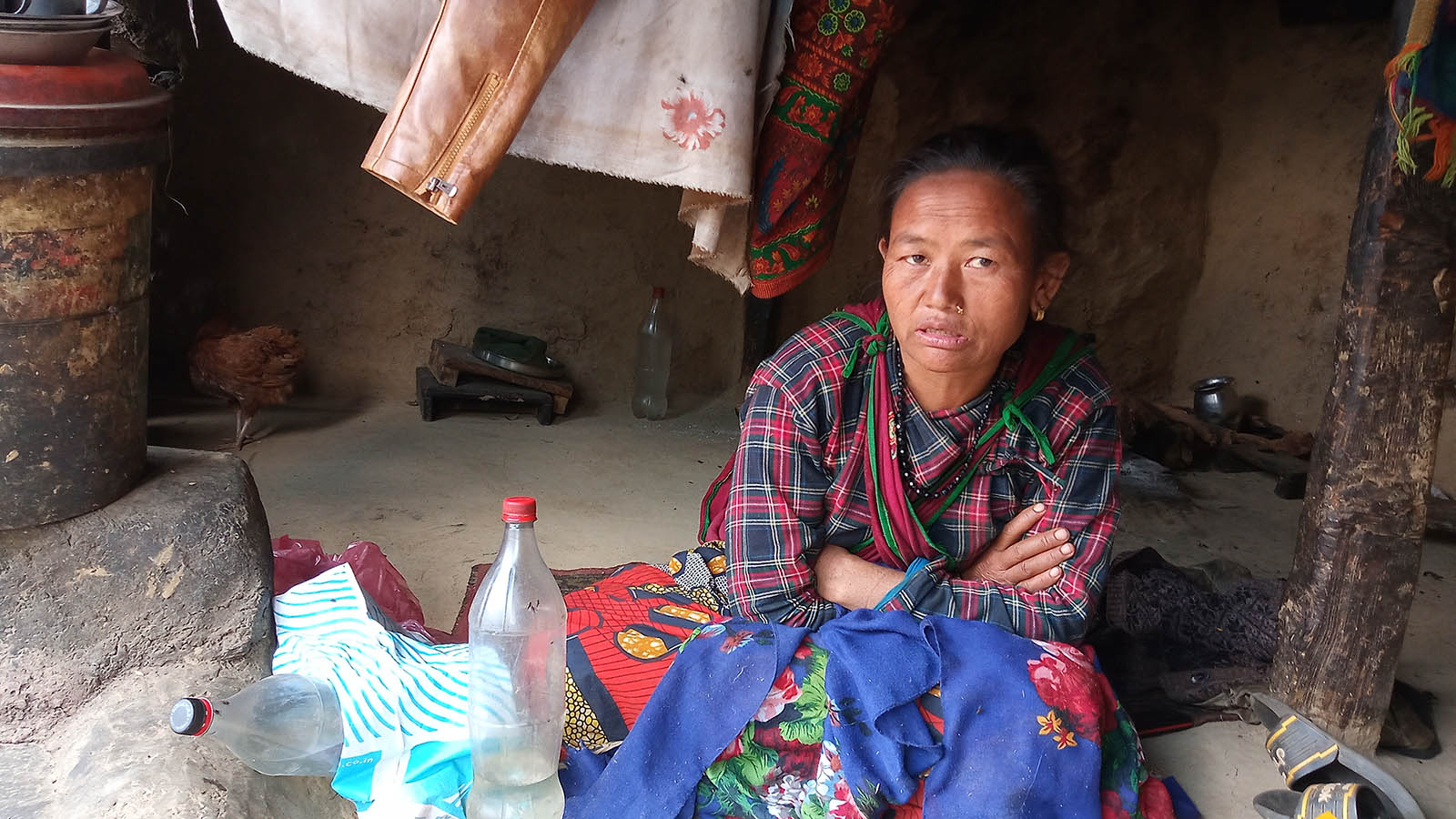
Nanda Kala Gharti
While those who got to the US through illegal routes and fortunately got refugee status there narrate their stories with pride, those who have been deported or returned from half-way have tragic tales to tell.
Nanda Kala Gharti, who lives in a small stone house on the upper flank of Tak village, spends her days in melancholy. Her husband Dhanlal had chosen to take the illegal route to the US, and Nanda Kala, a mother of four, is living with the repercussions of his decision. Dhanlal had entered the US after a six-month long arduous journey and was detained upon his entry. He had to spend four years in the detention camp and was finally deported to Nepal. He had already lost Rs6 million that included loans and the savings he had made while he was working in Qatar and Saudi Arabia.
Now Dhanlal and Nanda Kala are under pressure with creditors nagging them frequently. Nandakala said they have an insurmountable crisis in their hands. Pointing to her son, she exclaimed, “When will he grow up, go abroad and pay back the loans!”
Though they plan to sell the 105-sqm land in Khalanga, Rukum (West) that was bought with Dhanlal’s savings in Saudi, they haven’t found a client yet. To pay back the loan, Dhanlal tried to go to Croatia once and spent 15 days in Kathmandu for the process. But after he was turned down, he returned home dejected. “Now we will submit the passport to another agent [for Dhanlal’s trip abroad],” Nanda Kala said. “There’s no point staying here.”
Stories that echo each other
The situation in Sisne Rural Municipality is similar to that of Putha Uttarganga. Here, one can hear plenty of stories of those who have tried to go to the US and those who are fighting refugee cases there. Krishna Regmi, chair of the rural municipality, personally knows seven people who have been deported from the US.
Gangaram Khadka, a resident of Sisne Rural Municipality-3, runs a bee and chicken farm. Like other young men in his village, Khadka had headed off to the US via an illegal route on 27 March, 2018. He had reached the US via the New Delhi-Moscow-Barcelona-Bogota-Panama-CostaRica-Nicaragua-Honduras-Guatemala-Mexico route. When he finally arrived in the US, he was detained and spent 11 months in a detention camp. He was deported on 15 March, 2019. He had handed over Rs3.2 millions to the agent and spent Rs2 million to fight the case to become a refugee. “It’s not possible for me to pay back the loan while working in Nepal,” he said. “I aim to pay back some interest and head off abroad again.”
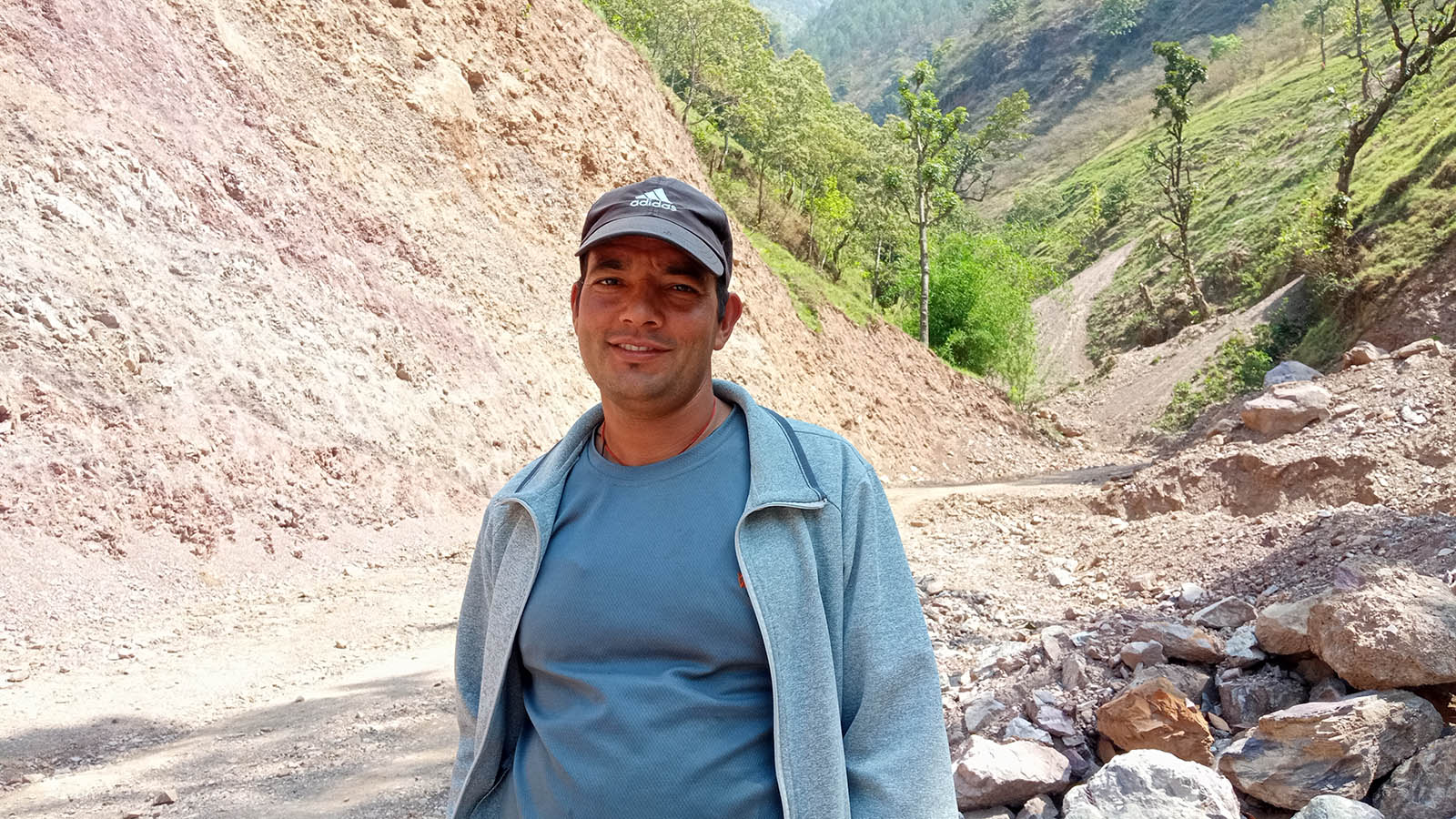
Ganga Ram Khadka, a resident of Mathillo Pokhara in Sisne-3 who was deported from the US.
For six months after Khadka was deported, he had anxiety and headache, he said, adding that the problems faced by the deported and their families are unspeakable. He further said that the three people from his village who were deported like him are also struggling with their mental health.
Keshav KC, a resident of Musikot in Rukum West, was a small-time contractor. He owned a Scorpio van and a bus and would easily make Rs50-60,000 in a month. But he aimed bigger. “When all my friends headed off to America, I too wanted to go,” he said, adding that as many as 20 people from Musikot-5 alone have so far gone to the US illegally.
He embarked on the US trip in June 2018. First, he went to Dubai on a tourist visa. After a month, he reached Ethiopia with help from agents. He stayed there for 22 days and after no door opened for him to go to the US, he returned to Kathmandu, where he stayed for a few days and then headed off Dubai again, and then to Chile via Sao Paulo, Brazil. Then on to Peru and Colombia. He then walked the ‘ghost trail’ of the Panama jungles to reach Costa Rica. He said that his group of trekkers had 12 Nepalis. He then travelled to Honduras, Guatemala and Mexico and then on to the US, finally. By that time, KC had already spent Rs3.2 million.
Like many other Nepalis taking the illegal routes, he was detained upon his arrival in the US. He stayed at the detention camp for 13 months and when his refugee application was denied, he was deported to Nepal. He had spent Rs5.4 million by then. Only then he knew that one shouldn’t try to go to the US through illegal channels, said KC, who is 35.
He added that walking on the route was a horrendous experience, as one had to endure constant scolding of the agents and also fight criminal gangs along the way. But why did he decide to go to the US? “First thing is there’s no employment opportunity here,” he said. “The parents also force their children to move abroad as all others of our age are doing the same to earn money.”
Tikaram Pun, a 40-year-old resident of Bohora village in Musikot-4, too is haunted by his past journey. In September 2017, he entered the US after crossing 17 countries with the help of organised human traffickers. Of the 41 people in his group, 31 were from Rukum east and west, he said.
Pun, who was detained upon his arrival in the US, spent 24 months in a detention camp. His refugee application was also refused and so he was deported along with eight other Nepalis. “I spent Rs9.2 million in the process,” he said. He only got back Rs500,000 from the agents back home. He then sold the 2 ropani land he owned at Rs1.3 million to pay back a fraction of the outstanding amount. “When I returned, I started having mental health problems. I still suffer from them,” he said. Pun is under pressure from creditors and relatives to pay back the loan. “I don’t have anything, how do I pay back?” he tells them.
Those who died on the way
A team of seven Nepalis and 10 Bangladeshis, including Rupak Bohora of Bafikot-3 in Rukum West, were on a mission to reach Costa Rica through Colombia, Caribbean Coast, Capuragana and Panama. But while they were crossing a sea, the boat they were riding on capsized. As many as 12 died in the incident, including six Nepalis. Rupak’s wife, Geeta, learned about the incident only after six days, on 25 June, 2021.
“I still don’t know what exactly happened,” said Geeta, who had been married off at age 19 and is now a mother of two daughters. The only thing she knows is that Rupak has died and she is now all alone. And that she has Rs5 million in loan taken for Rupak’s trip. She showed a picture of her husband on her phone to this scribe and said, “I only have memories.”
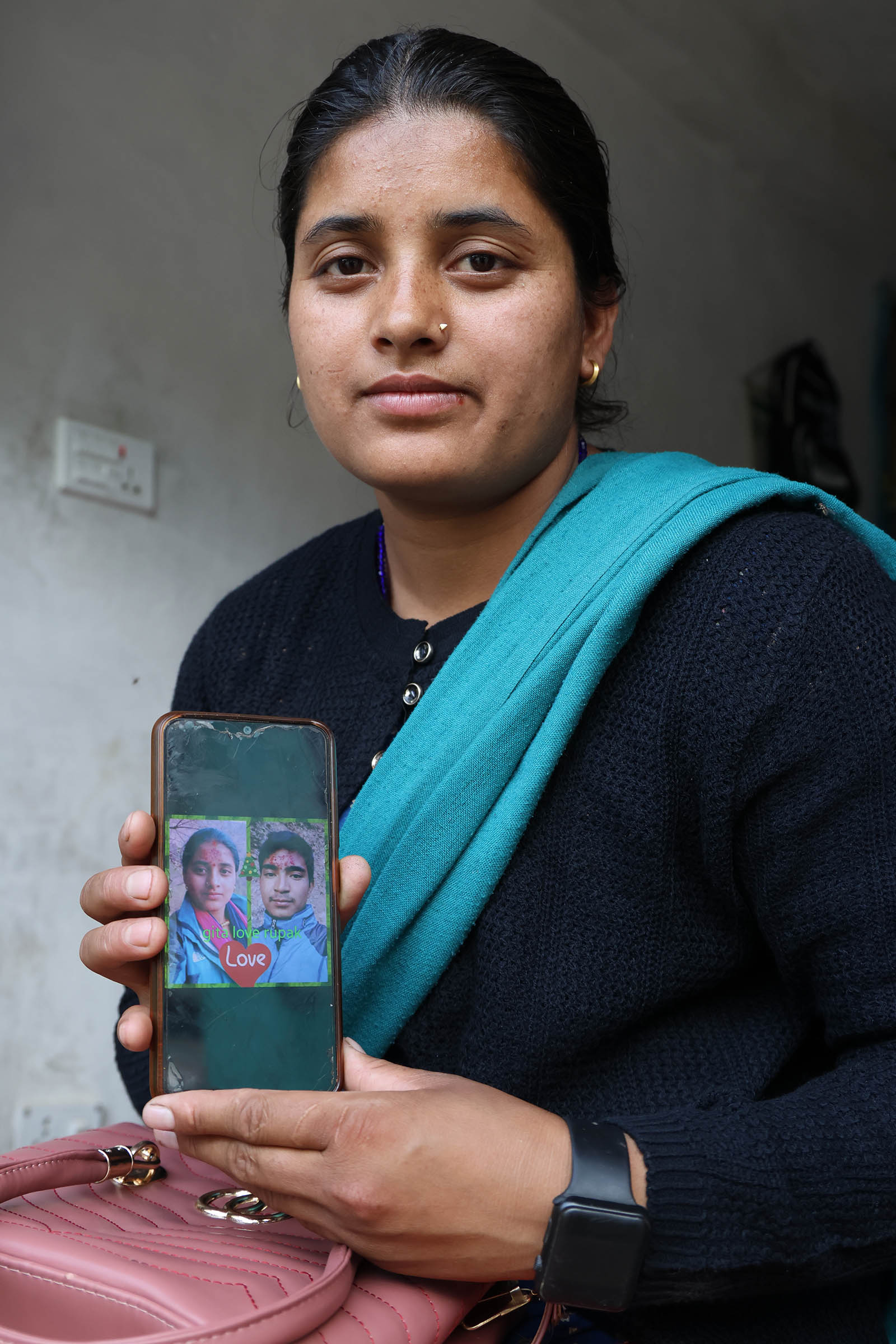
Geeta, 24, displays the photo of her husband who died after the boat he was on capsized while he was headed to Capuragana in Caribbean Coast from Nikkoli in Colombia.
Rupak’s dead body arrived in the village one and a half months after the incident. The family performed the funeral rites on the banks of Bheri river.
Angel Budhamagar, 21, from Dang’s Ghorai Sub-metropolis-12, was also on the same boat as Rupak. Angel’s father Rajendra’s looks shocked even after two years since the incident. “I feel an intense pain upon hearing the US and my son’s name,” he said.
According to the information Rajendra received, the agent had to pay USD300 to cross his son’s team over to Capuragana from Nikkoli. But the agent wanted to spend only USD100. “He aimed to save USD200 and took the life of my son,” Rajendra said.
Seven people had died in that incident but no families filed a complaint against the agent except for Rajendra, who registered a complaint against the Dang-based agent Top Bahadur GC with the Anti-Human Trafficking bureau. After the complaint, Top Bahadur is currently on the run.
After they received a tip-off that Top Bahadur had fled to Ukraine, Nepal Police issued a red corner notice through Interpol to detain him. Top Bahadur then surrendered himself and came to court hearing. But the Kathmandu District Court judge Shankar Raj Baral issued a clean chit for him on April 2, saying that the charge sheet doesn’t substantiate the offence.
Rajendra had spent nearly Rs3.2 million gained through land sale to send his son to the US. “We could make money again but my son won’t ever come back,” he said.
Lack of political concern and legal provisions
The concrete bridge over Chewang river is on the edge of Tak village. On the walls of the bridge are paintings of political theorists like Marx, Engels, Lenin, Stalin and Mao, and the iconic slogan, ‘Workers of the world, unite!’, below them. But the slogan appears to be at odds with life in the village. Given the phenomenon of illegal travels to the US through the help of organised human traffickers, the whole village appears to be emptying. Neither are the local governments concerned to stop the phenomenon nor are the political parties paying attention.
Puniraj Gharti, chair of Putha Uttarganga rural municipality, said that the number of those who have returned after half-way in their trip to the US exceeds those who have actually made it to the country. Though the trend is worrying, “there’s nothing we can do,” he said. “How could we stop them from making the trip when they are struggling to make a living in the village?”

Rajendra, the father of Angel Budha Magar, who died during the boat accident.
Krishna Regmi, chair of Sisne Rural Municipality, said that the vicious cycle of poverty started after marijuana farming was banned in the country. Then the Maoist insurgency added to the woe, forcing youths to migrate. The signing of the peace agreement in 2006 didn’t herald any change in the economy either and youths are struggling to get jobs. Organised human traffickers are cashing in on this sorry state of affairs, Regmi said. “Meter byajis [usurious lenders] are also promoting this phenomenon,” he added.
Janak Kumar Batha, chair of Bafikot rural municipality in Rukum West, said that everyone in his local unit wants to go to the US now. “How could we stop them?” he asked with quiet resignation. “No one is concerned about educating their children. Everyone wants to go to the US by any means.” According to the data he compiled himself, as many 493 people from Bafikot have reached the US so far. “All of them reached there through tallo bato,” he said. “As many youths are probably on the way.”
The phenomenon is equally rife in Dang’s Tulsipur and Ghorahi. Ramesh Kumar Pandey, chair of Ghorai-15, says that even though many heading to the US are swindled, no complaints are filed at the ward office. “Only those who attempt to go to Saudi Arabia or Qatar file the complaints.”
One can infer from Pandey’s statements that the families of such illegal travellers don’t want to publicise the ordeals of their family members. On the one hand, agents threaten them to not publicise the issue; on the other, they fear they themselves would be punished by law.
According to the Anti-Human Trafficking Bureau, in the five fiscal years after 2018-19, as many as 178 Nepalis, including 174 men, have been deported from the US. Of them, the highest 49 are from Rukum while 37 are from Dang. The data doesn’t include those who returned after making it to the half-way or those who have been fighting the legal battle in the US for refugee status. But this data is enough to show that many such youths are from the ‘base areas’ of the insurgency.
SSP Jeevan Shrestha, chief of the bureau, said that data on the number of such victims and the amounts they have spent is hard to collect since complaints are rarely filed with the police. “This is human trafficking but for a lack of law, we are still compelled to launch the cases as per Human Trafficking and Transportation (Control) Act 2074BS,” Shrestha said. “The Act provides a maximum penalty of Rs250,000 for the offenders and a compensation to the victims 50 percent of that.” Because of a lack of relevant law, police are compelled to also attract the theft and organised crime act to punish the offenders, he added.
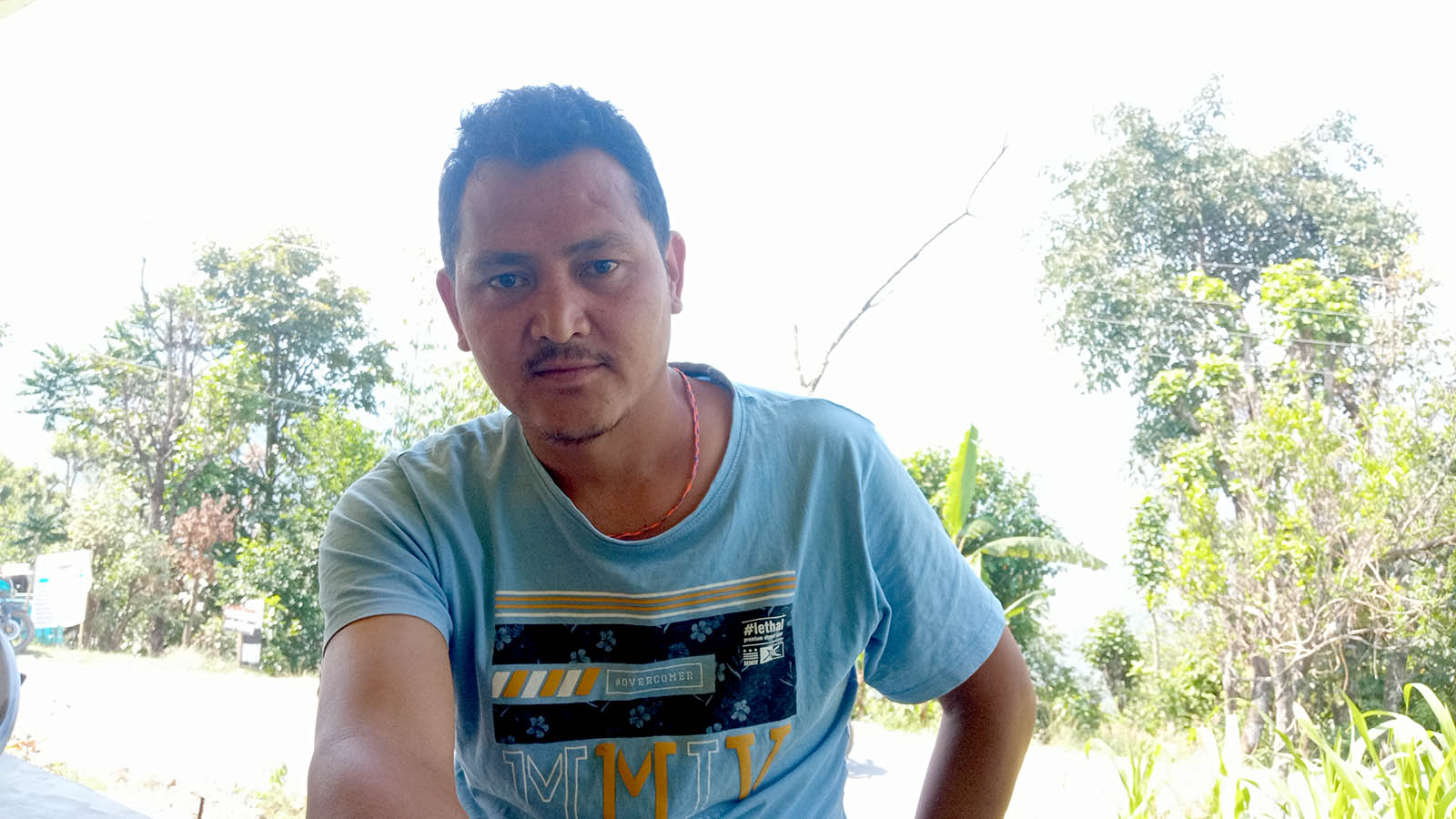
Tikaram Pun, 40, a resident of Bohora village in Musikot Municipality-4.
On the one hand, the police receive no complaints; on the other, the phenomenon is seeing a further rise.
The Chewan stream lies on the base of Takasera hill. At one corner of the stream lies Shri Kami’s meat shop. Kami had reached Saudi Arabia when he was all of 18, paying the agent Rs60,000. He stayed 11 years in Saudi Arabia and two years in Qatar. While he was toiling away at the gulf, his son aimed to go to the US through backdoor channels. Five years ago, his son returned home from Brazil where he had reached after a four-month journey through various countries and after failing to reach his destination, the US. He lost Rs2.7 million in the process.
But Shri’s son didn’t stop there. After staying home for a few months, he got in touch with another agent, aiming once again to go the US through backdoor routes. “He spent Rs3.4 million during his second attempt and further Rs3.2 million to acquire refugee status,” Shri said. Now his son is working in the US as a refugee. Shri, proud of his son’s travels, added, “One makes it big whether through confidence or by lying. My son did it through the former.”
There may be hardly any villages in Rukum east and west where no young man has attempted to go to the US through a backdoor route. Ask anyone in Musikot, the district headquarters of Rukum west, and they will tell you the name of a few youths who have entered the US through illegal routes. Everyone in the bazaar, from those running shops to schoolteachers to contractors, harbour one dream: to reach the US.
The 23-year-old son of Birman Puri, who runs a hotel near Syarputal in Bafikot-3 of Rukum West, is also in the US. He had reached there through illegal routes spending Rs4.7 millions. Puri estimates that as many as 90 youths from his ward have reached the US so far.
Bhaskar Gautam, a political scientist, says that the rise of the phenomenon of human trafficking in the insurgency’s ‘base areas’ is a knock-off effect of the political system’s abject failure.
While the Maoists raised issues related to livelihood, nationalism and a new kind of democracy during the insurgency, after the peace process, it is livelihoods that have been hit the hardest, Gautam said. “The traditional way of life and economy took a hit during the insurgency,” he said. “The development after the peace process also failed to address that. What sprang up was organised human trafficking.”
Dreams of rags to riches at 19
In Rukum and Dang, many parents have even sent their children below 19 years of age to the US through illegal routes, handing them over to organised traffickers. The agents would assure the parents that if their children reached the US before they were 19, they wouldn’t have to stay at detention centres and could get to work straight away. This has inspired many parents to force their children to take the risky trip.
On 23 April 2020, two adolescents from Bafikot in Rukum and Ghorahi in Dang headed off to the US through the illegal route. They were both barely 18 and the agents had convinced their parents that the teenagers would reach the US before they turned 19. They travelled to New Delhi from Kathmandu and then on to Malawi via Singapore and Colombo. The Covid pandemic had already set in by then and the teenagers got stranded in Malawi. The agents took them to a hotel in Blantyre city, 300km away from Malawi capital of Lilongwe, where the teenagers got stuck for months. The agents then fled from the hotel. Since they couldn’t pay their hotel fares, the teenagers were held hostage. The local police rescued them after 11 months and returned them to Nepal. Both of them had already spent Rs3.5 million each by then.
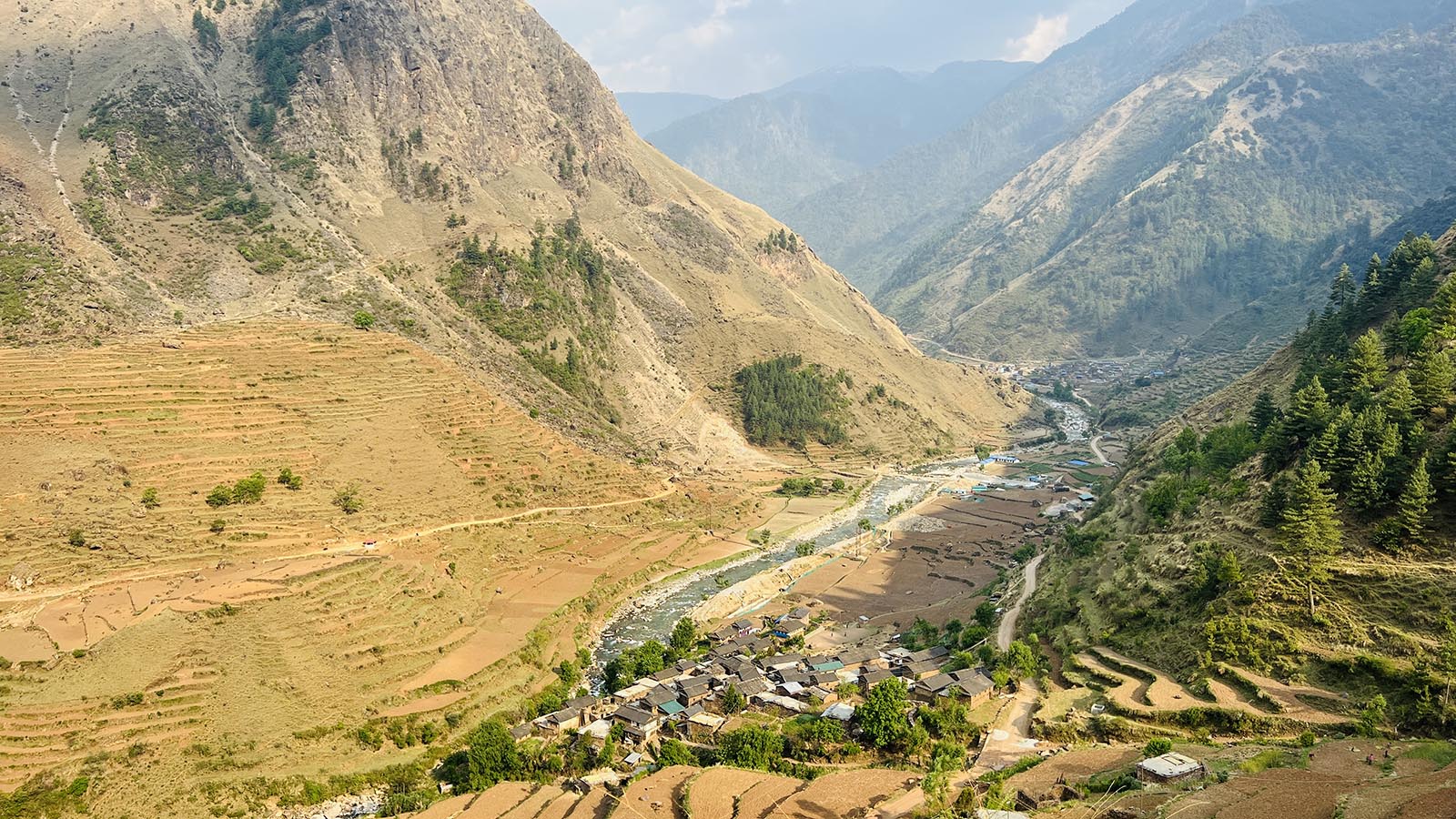
After they returned from Malawi, they tried to file a complaint at the Anti-Human Trafficking Bureau. But the then leadership of the bureau refused to take the complaint arguing that they had involved themselves in the ordeal, the parents of the teenagers say.
Three years after the incident, the teenagers had already left their home for another trip to the US, through another set of agents. In their second attempt, they had reached the US and had to spend only Rs1 million, said the mother of one of the young men. Another young man, however, said through a Messenger call that he had arrived in the US in June, 2021 by spending Rs4 million and had now started working there.
The owner of a popular hotel at Rukumkot, the headquarters of Rukum east, doesn’t know about the whereabouts of his son, who had left for the US. His son had reached the Mexico border, but was now stranded there for the past three months. He had reached there through the Dubai-Turkey-Panama-Peru-Spain-Algeria route. If he doesn’t make it to the US by February, 2024, he’d have already crossed the age of 19 and so might get into trouble.
When asked how he decided to send his son who was barely 18 for such a risky trip, he said, “All of his friends have headed for the US. How could I stop my son here?”
He claimed that there’s not a single household in Sisne Rural Municipality-3 that hasn’t sent their son for a trip to the US. “We would be able to tell the number of those who have stayed back,” he said. “But we can’t say the number of those who have left.”
Reporting contributed by Mahesh KC in Rukum east and Durgalal KC in Dang



